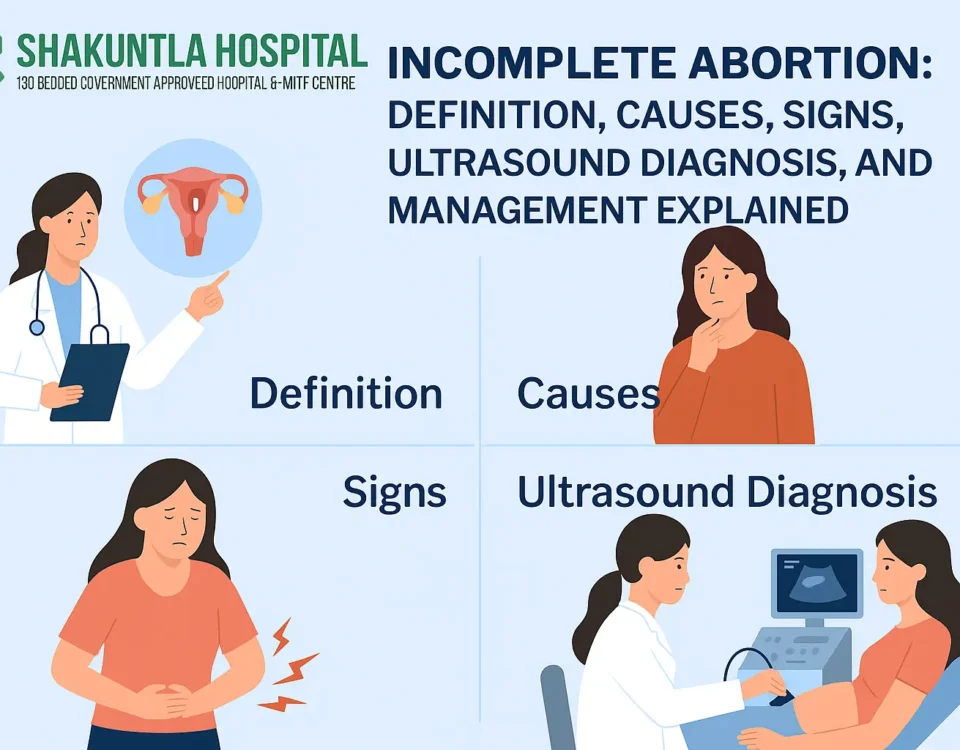High-Risk Pregnancy: Definition, Types, Risk Factors, Assessment, and Prevention Explained

Incomplete Abortion: Definition, Causes, Signs, Ultrasound Diagnosis, and Management Explained
June 19, 2025
Understanding Incomplete Abortion: Signs, Causes, Diagnosis, and Management
August 20, 2025Introduction
A high-risk pregnancy is one that threatens the health or life of the mother or baby. While many pregnancies progress normally, certain conditions—either pre-existing or developed during pregnancy—can increase complications and require specialized care. Understanding what makes a pregnancy high-risk is crucial for ensuring timely medical intervention and better outcomes for both mother and child. Whether it’s due to maternal age, chronic illnesses, or pregnancy-specific conditions, recognizing and managing risks early is essential. In this blog, we’ll explore the definition of high-risk pregnancy, its types, risk factors, methods of assessment, and practical steps for prevention to help expecting parents make informed decisions.
What is a High-Risk Pregnancy?
A high-risk pregnancy is defined as one in which the health or life of the mother, the baby, or both may be at greater risk than in a normal pregnancy. These risks may stem from pre-existing medical conditions, complications that develop during pregnancy, or external lifestyle factors. The primary goal in managing a high-risk pregnancy is to minimize the risk of complications through careful monitoring, early detection, and personalized care plans.
High Risk Pregnancy Definition
According to medical standards, the high risk pregnancy definition refers to any pregnancy that requires additional medical attention due to factors that could potentially threaten the well-being of the mother or fetus. These cases demand enhanced prenatal care, diagnostic testing, and often the involvement of specialists such as maternal-fetal medicine doctors.
How It Differs from a Normal Pregnancy
In contrast to a low-risk or uncomplicated pregnancy, a high-risk pregnancy includes:
- More frequent prenatal visits and ultrasounds
- Specialized tests such as genetic screenings, fetal echocardiograms, or Doppler studies
- Higher likelihood of requiring hospitalization, bed rest, or early delivery
- Increased need for maternal and fetal monitoring during labor
Key Factors That Contribute to a High-Risk Pregnancy
Some of the main contributors to a high-risk pregnancy include:
- Maternal age: Teen pregnancies or women over 35
- Pre-existing health conditions: Diabetes, high blood pressure, kidney disease, etc.
- Pregnancy-related complications: Gestational diabetes, preeclampsia, placenta previa
- Lifestyle factors: Smoking, alcohol consumption, substance abuse
- Fetal complications: Multiple gestation, birth defects, growth restrictions
Why Early Detection Matters
Understanding what is high risk pregnancy is crucial for early identification and intervention. Timely detection allows:
- Early treatment of maternal health issues
- Planning for specialized care and delivery options
- Reducing the chances of premature birth or delivery-related complications
- Better preparation and education for expecting parents
In summary, a high-risk pregnancy isn’t necessarily a dangerous one if managed correctly. With proper medical supervision and a well-monitored care plan, most high-risk pregnancies result in safe deliveries and healthy babies.
Types of High-Risk Pregnancy
There are several types of high-risk pregnancy, each with its own causes, concerns, and management needs. Identifying the specific type helps doctors plan effective care for both the mother and baby.
Common Types of High-Risk Pregnancy
- Multiple Gestation (Twins or More):
Carrying more than one baby increases the risk of premature birth, low birth weight, gestational diabetes, and preeclampsia. Close monitoring and possible early delivery are often necessary. - Advanced Maternal Age (35 Years or Older):
Women over 35 are more likely to experience fertility issues, chromosomal abnormalities (like Down syndrome), and complications such as high blood pressure or miscarriage. - Gestational Diabetes:
A form of diabetes that develops during pregnancy, affecting how cells use sugar. It can lead to larger babies, premature delivery, or the need for a C-section. - Hypertension Disorders (e.g., Preeclampsia):
High blood pressure during pregnancy can damage organs and restrict blood flow to the placenta, increasing the risk of fetal growth issues or placental abruption. - Preterm Labor:
Labor that begins before 37 weeks of pregnancy poses risks like underdeveloped lungs, low birth weight, and long-term health challenges for the baby.
Understanding the types of high risk pregnancy ensures that mothers receive specialized care tailored to their unique needs, improving outcomes for both mother and child.
Common High-Risk Pregnancy Factors
Several high risk pregnancy factors can influence the health of the mother, baby, or both. These factors may exist before conception or arise during pregnancy, and recognizing them early allows for proactive care and better outcomes.
1. Maternal Health Conditions
Pre-existing medical issues increase the likelihood of pregnancy complications:
- Diabetes (Type 1 or 2): Poorly managed blood sugar can lead to birth defects or large babies, requiring cesarean delivery.
- Heart disease or hypertension: These increase the risk of preeclampsia, organ strain, and placental issues.
- Thyroid disorders or autoimmune diseases: Can affect fetal growth and maternal well-being.
2. Body Weight Concerns
- Obesity: Raises the risk of gestational diabetes, sleep apnea, and delivery complications.
- Underweight: Can lead to poor fetal growth, preterm birth, and low birth weight.
3. Lifestyle Choices
- Smoking, alcohol, or drug use: Harmful substances can lead to birth defects, miscarriage, stillbirth, and developmental problems.
4. Pregnancy History
- Previous complications: A history of miscarriage, preterm labor, or C-section raises future risk.
5. Genetic and Fetal Issues
- Inherited disorders or chromosomal abnormalities may require advanced fetal testing and specialized monitoring.
By understanding these high risk pregnancy factors, expecting parents and healthcare providers can collaborate on a care plan that ensures safety and preparedness throughout pregnancy.
Assessment of High-Risk Pregnancy
The assessment of high risk pregnancy is a critical step in ensuring both maternal and fetal health throughout the pregnancy journey. It helps healthcare providers detect potential complications early and take necessary precautions.
How High-Risk Pregnancies Are Identified
Healthcare providers begin by evaluating a woman’s medical history, lifestyle, and previous pregnancies to determine risk levels. Once risks are identified, more frequent and detailed monitoring is scheduled.
Key Monitoring and Diagnostic Tools
- Ultrasound Scans: Used to track fetal growth, amniotic fluid levels, and placental position.
- Blood Tests: Help detect gestational diabetes, anemia, infections, and hormone levels.
- Genetic Testing: Includes tests like NIPT or amniocentesis to screen for chromosomal abnormalities or inherited disorders.
- Biophysical Profile (BPP): Combines ultrasound and fetal heart rate monitoring to assess baby’s well-being.
- Non-Stress Tests (NST): Monitor fetal heart rate patterns in response to movement.
Why Regular Prenatal Care Matters
Regular prenatal visits are essential for early intervention. They allow doctors to adjust care plans, provide necessary treatments, and prepare for any delivery-related complications. The assessment of high risk pregnancy ultimately ensures a safer outcome for both mother and baby.
High-Risk Pregnancy List
A variety of medical, lifestyle, and pregnancy-related factors can place a woman in the high-risk category. Below is a concise high risk pregnancy list that includes common conditions and scenarios requiring extra care:
- Teenage pregnancy (under age 17)
- Advanced maternal age (over 35 years)
- Multiple gestation (twins, triplets, or more)
- Chronic illnesses such as diabetes, hypertension, epilepsy, or kidney disease
- Placenta previa (placenta covering the cervix)
- History of miscarriage or preterm labor
- Gestational diabetes or preeclampsia
- Infections during pregnancy (e.g., HIV, hepatitis, Zika virus)
- Obesity or being underweight
- Substance abuse (smoking, alcohol, or drugs)
- Birth defects or genetic disorders in the fetus
Being aware of the high risk pregnancy list allows women and their healthcare providers to take preventive steps, ensuring a safe and healthy pregnancy journey.
Prevention of High-Risk Pregnancy
While not all complications can be avoided, the prevention of high risk pregnancy is possible in many cases through proactive planning, healthy habits, and early medical guidance. By taking certain steps before and during pregnancy, women can greatly reduce their risk of complications.
How to Prevent High Risk Pregnancy
Here are essential tips that help in managing or lowering pregnancy-related risks:
- Maintain a Healthy Lifestyle Before Conception:
Exercise regularly, eat a balanced diet, and reach a healthy weight before trying to conceive. - Seek Proper Prenatal Care:
Regular checkups allow early detection and management of potential issues. - Manage Existing Health Conditions:
Work with your healthcare provider to control conditions like diabetes, hypertension, or thyroid problems. - Avoid Harmful Substances:
Refrain from smoking, alcohol, recreational drugs, and certain over-the-counter medications. - Focus on Nutrition and Stress Management:
Ensure adequate intake of iron, folic acid, and prenatal vitamins, and practice stress-reducing techniques like meditation or light exercise. - Consider Pre-Pregnancy Counseling:
For women with prior pregnancy complications or medical conditions, a planned and supervised pregnancy can reduce risk.
Understanding how to prevent high risk pregnancy empowers women to take charge of their reproductive health and ensure a safer journey to motherhood.
When to See a Specialist
If you experience symptoms like high blood pressure, abnormal ultrasound results, bleeding, severe abdominal pain, or a history of pregnancy complications, it’s important to consult a maternal-fetal medicine (MFM) specialist without delay. Early expert intervention can prevent life-threatening outcomes for both mother and baby.
For those seeking expert guidance in Delhi, Dr. Varsha Sharma, a highly experienced specialist in high-risk pregnancies, is available at Shakuntala Hospital, Delhi. With her expertise and compassionate care, expecting mothers receive the personalized attention they need throughout their pregnancy journey.
Conclusion
Understanding and managing a high-risk pregnancy is crucial for protecting the health of both mother and child. Whether due to medical conditions, lifestyle factors, or complications that arise during pregnancy, timely care can make a significant difference. With regular prenatal visits and guidance from specialists in fields like Obstetrics and Gynecology, women can better navigate risks and ensure safer outcomes.
At institutions like Shakuntala Hospital, expert services in Cosmetic Gynecology and advanced support from the Infertility Clinic also help address broader reproductive health needs. Awareness, early action, and comprehensive care are the keys to a healthy and empowered pregnancy journey.




